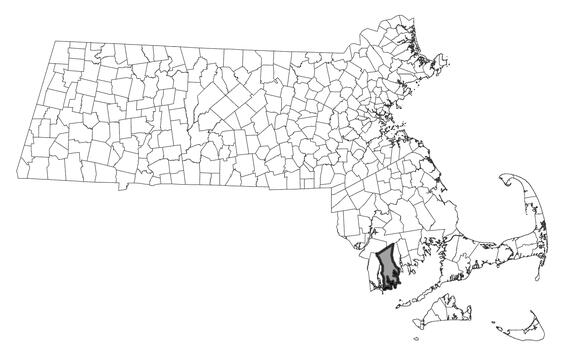- Scientific name: Eleocharis microcarpa
- Species of Greatest Conservation Need (MA State Wildlife Action Plan)
- Endangered (MA Endangered Species Act)
Description
The tiny-fruited spike-sedge (Eleocharis microcarpa) is a small (up to 3 dm [1 ft] tall), densely clustered, annual herb with slender, threadlike stems. Although the tiny-fruited spike-sedge and the other spike-sedges (also called spike-rushes) do superficially resemble the group of plants called “rushes,” they do not belong to the rush family, and are actually members of the sedge family (Cyperaceae). The spike-sedges have a single, tight cluster of inconspicuous flowers (a “spike”) at the apex of each stem. The stems of spike-sedges appear leafless, and in fact these plants do not have leaf blades (the expanded part of the leaf), only leaf sheaths (the part which surrounds the stem). Some stems of the tiny-fruited spike-sedge are erect, and others arch. This species is able to reproduce vegetatively when flowers on arching stems are replaced by vegetative propagules called “bulbils.”
To positively identify the tiny-fruited spike-sedge and other spike-sedges (genus Eleocharis), a technical manual should be consulted. It is usually necessary to look at the tiny fruits of the plant under magnification to distinguish the species of spike-sedge. Members of this genus possess a type of fruit called an “achene,” which is hard and nut-like and does not split open to release its seed. Achenes in the spike-sedges are topped by a protuberance (called a “tubercle”), which varies in shape, size, and texture among species. The tiny-fruited spike-sedge is named for its minute achene, which is only 0.6-0.8 mm (0.02-0.03 in) wide. It is three-sided and pearly white at maturity in mid-summer. In contrast, most spike-sedge achenes are brown, yellow, or green. The surface of the tiny-fruited spike-sedge’s achene appears smooth under a hand lens or microscope. The tubercle is quite small in comparison to the achene, and resembles a tiny cap.
There are several common spike-sedges that could be confused with the tiny-fruited spike-sedge. The soft-stemmed spike-sedge (Eleocharis obtusa), which sometimes occurs with the tiny-fruited spike-sedge in Massachusetts, is another tufted annual that differs in having a lens-shaped achene (instead of triangular) and in its more robust appearance. Its stems are usually taller and thicker than the delicate, thread-like stems of the tiny-fruited spike-sedge. Another associated species, the tubercled spike-sedge (Eleocharis tuberculosa), has flattened stems and a tubercle that is much larger than that of the tiny-fruited spike-sedge; in fact, in the tubercled spike-sedge, the tubercle is as large as the achene. A common spike-sedge with very slender stems that also forms dense tufts is the needle spike-sedge (Eleocharis acicularis). It is distinguished from the tiny-fruited spike-sedge by its diminutive stature (only up to 1.2 dm tall, at most), and its long, gray, ornamented achene that is roundish in cross-section, rather than strongly triangular. The slender spike-sedge (Eleocharis tenuis) is thin-stemmed, but the stems are usually 4- to 8-angled (instead of round) and are usually scattered or only loosely clustered. In addition, the achenes of the slender spike-sedge are rough or pitted in appearance when observed under a hand-lens.
Life cycle and behavior
This is an annual sedge.
Population status
This species is considered to be rare throughout New England. It reaches the northern extent of its range in Bristol County, Massachusetts. The tiny-fruited spike-sedge is listed under the Massachusetts Endangered Species Act as Endangered. All listed species are protected from killing, collecting, possessing, or sale and from activities that would destroy habitat and thus directly or indirectly cause mortality or disrupt critical behaviors. The MassWildlife’s Natural Heritage & Endangered Species Program database has 2 records from Bristol County. Both records have been observed within the last 25 years.
Distribution and abundance
The tiny-fruited spike-sedge is known to occur primarily along the Atlantic coastal plain from Massachusetts south to Florida, and west to Texas, Indiana, and Tennessee.

Distribution in Massachusetts. 1999-2024. Based on records in the Natural Heritage Database.
Habitat
The tiny-fruited spike-sedge can be found growing in open, acidic, often sandy, seasonally wet areas of the coastal plain. It appears to be disturbance-adapted and is found in Massachusetts in abandoned sandpits. Other plants it is known to occur with include the tubercled spike-sedge (Eleocharis tuberculosa), the soft-stemmed spike-sedge (Eleocharis obtusa), Plymouth gentian (Sabatia kennedyana), pondshore rush (Juncus pelocarpus), slender-leaved goldenrod (Euthamia caroliniana), and threeway sedge (Dulichium arundinaceum).
Healthy habitats are vital for supporting native wildlife and plants. Explore habitats and learn about conservation and restoration in Massachusetts.
Threats
It is adapted to thrive in disturbed soil, yet too much disturbance, such as through extensive off-road vehicle use of the habitat, could be detrimental to large numbers of existing plants.
Conservation
As for many rare species, exact needs for management of tiny-fruited spike-sedge are not known. The following comments are based primarily on observations of populations in Massachusetts. Because this spike-sedge is found in human-created habitats, it presents an interesting management challenge. Because of its annual, ruderal nature, it is expected that this species will colonize nearby, newly-created disturbances over time. To maintain the tiny-fruited spike-sedge in existing locations, succession should be halted and soil exposed to encourage germination of the achenes of this annual species.
Contact
| Date published: | May 7, 2025 |
|---|